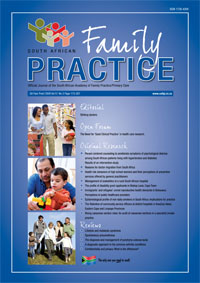Health Risk Behaviors of High School Learners and their Perceptions of Preventive Services offered by General Practitioners
Keywords:
health risk behaviors, high school learners, adolescent preventive services, general practitioners
Abstract
Background: Adolescence spans nearly a decade in which young people may initiate health risk behaviors like unsafe sexual practices and alcohol, tobacco and other drugs use (ATOD use). Most adolescent mortality and morbidity, attributable to such health risk behaviors, are preventable. Managing the consequences of health risk behaviors is costly and does not reduce the number of young people initiating these unhealthy lifestyle choices. The emphasis needs to shift towards the provision of adolescent primary and secondary preventive services. Overseas efforts involve national health risk behavior screening, the application of national guidelines for primary health care workers in all contexts and continuing evaluation so that appropriate region specific policies can be instituted. With the completion of our second South African National Health Risk Behavior survey and the implementation and evaluation of the National Adolescent Friendly Clinic Initiative in government clinics, we lack national guidelines for the primary health care worker to administer adolescent preventive services. Furthermore, the NAFCI initiative does not involve the general practitioner in the private sector. The aim of the research is to assess how the economically disadvantaged youth from public schools access the private sector general practitioner for preventive services related to health risk behaviors. Methods: This cross-sectional descriptive study was conducted among senior high school learners (Grades 10, 11 and 12) from 18 randomly selected secondary public, co-educational schools with an ordinary curriculum in the Johannesburg educational districts, during the first three school terms of 2002. A self administered research questionnaire was used to ascertain learners self reported involvement in health risk behaviors and their interaction with their GP in dealing with these health risk behaviors. Results: 1139 learners completed the research questionnaires. 1. Learners reported a high prevalence of health risk behaviors: 65% for alcohol use, 57% for sexual activity, 39% for tobacco use and 15% for drug use. 2. The predominant pattern of substance use was the experimental pattern of having tried these substances: 40% for cigarette use, 53% for alcohol use, 54% for injected drug use and 57% for other drug use. The majority of sexually active adolescents were practicing unsafe sex (55% had multiple partners, 52% without condoms and 28% without family planning). 3. Learners reported a high prevalence of coexisting health risk behaviors: 44% for alcohol use and sexual activity, 36% for tobacco and alcohol use and 26% for tobacco use and sexual activity. 4. Risk perception was lower for sexual activity (25% felt in danger and 5% felt affected) than for substance use (an average of 82% felt in danger and 40% felt affected). Of the 1139 learners, only 271 learners (24%) had a GP in private practice. 1. The adolescent-GP interaction was favorable for preventive service delivery: 70% of learners had medical aid cover, 41% were seeing their GP for more than five years, 92% were the “family�? doctor, 80% had visited their GP in the past 6 months and 60% had consulted on their own at least once. 2. Primary preventive service delivery to those not involved in health risk behaviors was poor: 28% for sexual activity, 24% for drug use, 23% for alcohol use and 19% for tobacco use. 3. Uncovering of health risk behaviors occurred to varying degrees: 40% for sexual activity, 18% with alcohol use, 18% with tobacco use and 11% with drug use. 4. Secondary preventive service delivery to those involved in health risk behaviors was better: averages of 89% for sexual activity, 84% for drug use, 54% for tobacco use and 38% for alcohol use. Statistically significant learner and general practitioner demographics highlighted the complex dynamics involved in this interaction. Conclusions: The study showed that adolescents from economically disadvantaged backgrounds have a high prevalence of health risk behaviors but utilize the general practice resource to a limited degree. Despite the interaction between adolescent and general practitioner being conducive to the receipt of primary and secondary preventive services, this was not optimal.
Published
2009-04-25
Section
Original Research
By submitting manuscripts to SAFP, authors of original articles are assigning copyright to the South African Academy of Family Physicians. Copyright of review articles are assigned to the Publisher, Medpharm Publications (Pty) Ltd, unless otherwise specified. Authors may use their own work after publication without written permission, provided they acknowledge the original source. Individuals and academic institutions may freely copy and distribute articles published in SAFP for educational and research purposes without obtaining permission.

